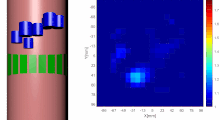
Back 電気容量トモグラフィ Japanese Elektrische capaciteitstomografie Dutch Elektryczna tomografia pojemnościowa Polish Tomografia por capacitância elétrica Portuguese


Electrical capacitance tomography (ECT) is a method for determination of the dielectric permittivity distribution in the interior of an object from external capacitance measurements. It is a close relative of electrical impedance tomography[2] and is proposed as a method for industrial process monitoring.
Although capacitance sensing methods were in widespread use the idea of using capacitance measurement to form images is attributed to Maurice Beck and co-workers at UMIST in the 1980s.[3]
Although usually called tomography, the technique differs from conventional tomographic methods, in which high resolution images are formed of slices of a material. The measurement electrodes, which are metallic plates, must be sufficiently large to give a measureable change in capacitance. This means that very few electrodes are used, typically eight to sixteen electrodes. An N-electrode system can only provide N(N−1)/2 independent measurements. This means that the technique is limited to producing very low resolution images of approximate slices. However, ECT is fast, and relatively inexpensive.
- ^ Wanta, Damian; Smolik, Waldemar T.; Kryszyn, Jacek; Wróblewski, Przemysław; Midura, Mateusz (2022). "A Run-Time Reconfiguration Method for an FPGA-Based Electrical Capacitance Tomography System". Electronics. 11 (4): 545. doi:10.3390/electronics11040545.
- ^ M Soleimani, W R B Lionheart, Nonlinear image reconstruction in electrical capacitance tomography using experimental data, Meas. Sci. Technol., 16, 2005, pp 1987–1996
- ^ S M Huang, A Plaskowski, C G Xie and M S Beck, Capacitance-based tomographic flow imaging system, Electronics Letters, 24 (7), 1988, pp 418–19.
© MMXXIII Rich X Search. We shall prevail. All rights reserved. Rich X Search